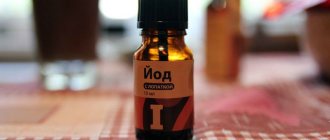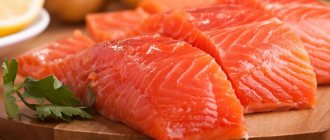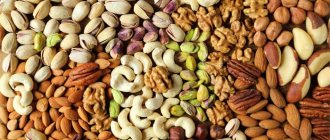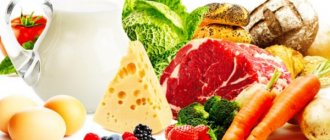Along with proteins and carbohydrates, fats are a basic micronutrient necessary for life. They serve as the main source of energy for the body.
Fat is an organic substance that is a concentrated source of calories. It enhances the taste of many foods, making them more nutritious, but unlike fiber, it does not give a feeling of fullness.
We consume fat in the form of triglycerides. A triglyceride molecule consists of three fatty acids, which in turn contain chains of carbon and hydrogen.
One way to classify fats is by the length of their carbon chains:
- Short chain fatty acids: less than 6 carbon atoms.
- Medium chain fatty acids: 6–12 carbons.
- Long chain fatty acids: 13–21 carbons.
- Very long chain fatty acids: 22 or more carbon atoms.
Most of the fats we consume are long chain fatty acids.
Edible fats can be of vegetable origin (sunflower, olive, flaxseed oil, etc.) and animal (lard, butter, fish oil, etc.), and by consistency - liquid and solid.
Types of dietary fats
Functions of fats in the body
Fats perform a number of vital functions:
- Energy.
Fat provides a huge influx of energy, which is almost impossible to achieve by consuming only proteins and carbohydrates. Each gram of fat provides 9 calories. By comparison, proteins and carbohydrates provide only 4 calories per gram of weight. Without fat reserves, our body literally begins to eat itself, breaking down tissue and muscle in search of material for energy production. - Hormones and genes.
According to the study, fats regulate the production of reproductive and steroid hormones, and also lead to changes in metabolism, cell growth and differentiation. During menopause in women, fat partially takes over the function of the ovaries and produces sex hormones. - Protection.
Organs in the human body are enveloped by a fatty membrane, which helps insulate them from injuries, concussions and other environmental influences. - Brain activity.
Adequate fat intake is important for brain health and also has a positive effect on mood and reduces irritability. - Absorption of vitamins A, D, E and
K. They dissolve thanks to fats. - Appearance.
When consuming enough fat, the skin becomes elastic and firm; if there is a lack of microelement, you may notice dryness and flaking. - Thermoregulation
. Fats protect the body from hypothermia and act as a heat insulator.
It is worth noting that there are fats that benefit the body and are necessary for the normal functioning of the body, as well as those that have a negative effect and lead to disease. But first things first.
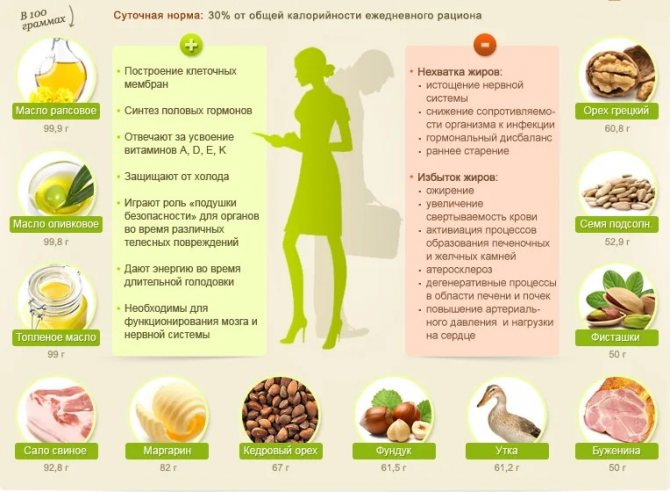
Positive and negative properties of dietary fats
General information about fats and their functions
Fats and their functions for the body
Fats are one of the most important components in human nutrition. And all the prejudices that they need to be completely excluded from your diet are false, because the role of fats in the human body is very great. The main thing is to know which types of lipids can be dangerous and which, on the contrary, are beneficial.
The main purpose of organic compounds:
- Energy. The process of fat oxidation releases a huge amount of energy. The breakdown of 1 gram of fat produces approximately 40 kJ of energy, which is several times more than the breakdown of proteins and carbohydrates.
- Construction function. They take part in the formation of cells of all organs.
- Regulatory. These elements take part in metabolism.
- Protective. Thermoregulation and mechanical protection of organs and skin.
- Supplies endogenous water. When 100 g of a substance is synthesized, approximately 108 g of water is released.
Lack of lipids can cause hormonal imbalances and disrupt the functioning of life support organs.
Types of dietary fats
The quality composition of the fats consumed is of great importance. They consist of special organic “building blocks” - fatty acids. Those according to their chemical structure are divided into monounsaturated, polyunsaturated, saturated and trans fats.
Monounsaturated fats
Monounsaturated fats are associated with several health benefits, including a reduced risk of heart disease and diabetes. One of the studies was based on 42 reports, in which 841 thousand subjects took part. It was concluded that proper fat intake leads to an overall reduction in the risk of mortality from all causes by 11%, and, for example, from stroke by 17%.
Studies have also shown that diets with monounsaturated fats lead to significant reductions in blood sugar, triglycerides, weight and blood pressure compared to diets high in carbohydrates.
In addition, monounsaturated fats increase the feeling of fullness, which leads to lower calorie intake.
What products do they contain?
- Olive oil
- Olives
- Macadamia nuts
- Almond
- Hazelnut
- Pistachios
- Peanut
- Avocado
- Pork
- Beef
Polyunsaturated fats
Polyunsaturated fatty acids contain two or more double bonds. These include Omega-3 and Omega-6.
According to the study. Omega-3 fatty acids are beneficial for autoimmune diseases, inflammation, and cardiovascular problems.
One study also concluded that taking Omega-3 supplements is effective against primary depression.
Omega-6 fats are found in most plant and animal foods.
Omega-3 rich foods:
- Salmon
- Sardines
- Herring
- Mackerel
- Anchovies
- Chia seeds
- Flax seeds
- Walnuts
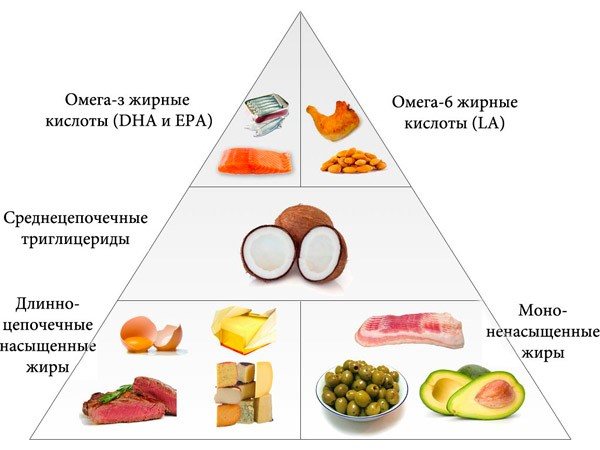
Division of fatty acids depending on chemical structure and molecular bonds
Saturated fats
Eating too much saturated fat raises blood cholesterol levels, which can lead to heart problems. Cholesterol is vital for the body to produce testosterone, estrogen and bile acids, but in small quantities.
It is worth clarifying that not all saturated fats are so dangerous. Research shows that triglycerides in coconut and palm oil can increase metabolic rate and reduce calorie intake when consumed in moderation.
Many countries have national dietary guidelines (eg Britain, Australia, USA) and they agree that replacing some of the saturated fat in the diet with unsaturated fat is essential for healthy body function.
The World Health Organization states that saturated fat should account for less than 10% and trans fat less than 1% of total energy intake.
Healthy foods containing saturated fats:
- Dairy products
- Coconut oil
- Mascarpone cheese
- Cheddar cheese
- Lamb
Trans fats
These are the most harmful of fats. Especially those used in processed foods. They are produced by adding hydrogen to unsaturated fats.
Excessive consumption of trans fats can lead to a number of health problems: inflammation, unhealthy changes in cholesterol, impaired artery function, insulin resistance and excess weight.
Research shows that replacing trans fats with other fats can reduce the risk of heart disease by up to 40%, depending on the type and amount of fat replaced.
They are often found in margarine and other processed spreads. Food manufacturers sometimes add them to packaged foods such as crackers to extend shelf life.
What other products contain it?
- Fast food
- Mayonnaise
- Chips
- Semi-finished products (cutlets, pancakes, pies, pizza, etc.)
- Popcorn
- Bakery
Based on the above, healthy fats are distinguished from harmful ones. The last category, as well as the abuse of saturated fats, is considered harmful. The first two are considered useful.
In Ukraine, it is mandatory to indicate on the label the presence of trans fats in a product, but please note that it will be labeled “hydrogenated oil.” Read food labels and ingredients carefully.
Lipid categories
All lipids are usually divided into two categories: harmful (saturated, cholesterol, trans fats) and healthy (unsaturated).
| Saturated | Unsaturated | ||
| Oil | Monounsaturated | Polyunsaturated | |
| Milk | Omega-9 | Omega-3 | Omega-6 |
| Yogurt | Olives and olives | Fish and seafood | Avocado |
| Cheese | Olive oil | Nuts and seeds | Grape seed oil |
| Yolk | Peanut oil | Legumes | Corn oil |
| Salo | Mustard oil | Cereals | Walnut |
| Cacao butter | Lard | Vegetable oils | Cottonseed oil |
| Palm oil | Sunflower oil | Some vegetables | Soybean oil |
"Bad" fats
As mentioned earlier, harmful lipids include saturated fats, cholesterol and trans fats. It is worth saying that frequent use of these substances leads to obesity, diabetes, cardiovascular diseases and increased cholesterol in the blood, which causes blockage of blood vessels. Dangerous products include: meat, dairy products, cheeses, yolk, chicken skin and fast food.
What determines the appearance of fat in the body?
- Genes.
A 2021 study estimates that about 50 percent of fat distribution can be determined by genetics. If most people in your family have big bellies or full thighs, there's a good chance you'll suffer the same fate. - Floor
. Men's healthy body fat levels range from 6 to 24 percent, and women's levels range from 14 to 31. Men tend to store more fat in the midsection, while women store more in the thighs and buttocks. - Age.
Older people have higher body fat levels due to slower metabolism and decreased muscle tissue. - Hormone levels
. Weight and hormones are closely related, especially after 40 years. This is due to the natural decrease in testosterone in men and estrogen in women.
The following types of fat are concentrated in the human body:
- White. This is the type that most people think of when they hear the word "fat." Women's bodies normally consist of 15-30% of it. It helps store energy and produces hormones.
- Brown. Unlike white fat, it expends energy and also provides the body with thermogenesis. Its content in the body is insignificant, located in the kidneys, back, shoulders and neck.
- Subcutaneous. Corresponds to its name and is localized under the epidermis. Makes up 90% of all body fat. It also protects against hypothermia, stores energy, and is also intended for pregnancy and breastfeeding.
- Visceral. The most dangerous type of fat is located around the organs in the abdominal cavity. Causes cardiovascular problems, increases cholesterol and can lead to type 2 diabetes.
The three main factors that contribute to the accumulation of fat are an unbalanced diet, a sedentary lifestyle (lack of physical activity) and stress. Moreover, chronic stress causes the body to gain visceral fat, which is so dangerous for humans.
"Good" lipids
This is what biochemists and nutritionists around the world call healthy unsaturated fats. They are divided into two categories: polyunsaturated and monounsaturated. It is worth noting that representatives of this category are in a liquid state at room temperature.
Omega-9
Oleic acid or omega-9 is a monounsaturated fatty acid. The real record holder for the content of this acid is olive oil. It is omega-9 that ensures the normal functioning of many systems in our body and is responsible for the formation of the cell membrane. If the body is deficient in this acid, it is replaced by other fatty acids. In this case, the structure of cell membranes does not change for the better, and this provokes metabolic disorders. The role of omega-9 in the body:
- Prevents the development of diabetes;
- Reduces the risk of hypertension;
- Prevents cancer;
- Strengthens the immune system;
- Normalizes blood pressure;
- Normalizes the functioning of the gastrointestinal tract;
- Strengthens and improves the appearance of hair, skin and nails.
In addition, omega-9, unlike other beneficial lipids, does not oxidize during heat treatment and long-term storage.
Omega-6
Omega-6 fats are among the most important fats in the human body. Their role in the human body is to prevent premature aging, heart disease and even cancer. Other properties of omega-6:
- Reduces blood cholesterol levels;
- Have a therapeutic effect in multiple sclerosis;
- Relieves unpleasant symptoms of PMS;
- Gives skin radiance and smoothness;
- Strengthens nails.
With a lack of this organic substance, a person experiences depression, fatigue, irritability, and memory impairment. In addition, deficiency of the substance affects the appearance: brittle and dull hair, brittle nails, skin diseases, obesity.
Omega-3
This substance is not produced independently, but is responsible for the functioning of many processes in the body:
- Normalizes metabolism;
- Thins the blood;
- Helps normalize weight;
- Improves brain function;
- Has a positive effect on the skin;
- The main source of energy without the risk of weight gain.
Fat intake guidelines
The amount of dietary fat you consume per day should be based on the type of diet you choose and your goal (weight loss, gain, or maintenance).
People whose weight is within the normal range need to consume 1-1.1 g of fat per kilogram; overweight and obese people need to consume 0.7-0.8 g of fat per 1 kg.
In a healthy diet, fats should make up 25-35% of your average daily calories. You should not lower your fat levels below normal, as this can be fraught with hormonal imbalances. Many people think that by reducing fat to 0.5 g per kilogram of weight, they will lose weight faster, but this is not so. We get fat not from fat, but from excess calories. Therefore, for comfortable weight loss, it is important to maintain a calorie deficit and BJU balance.
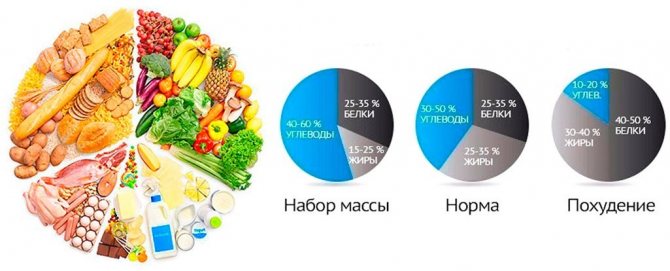
The ratio of proteins, fats and carbohydrates in the diet
You will be surprised how few products you need to consume to meet your daily requirement.
An example of the ratio of 100 g of product and the fats contained in it: walnuts - 60.8 g of fat, in dark chocolate 35.4 g, in ice cream 15 g, in Dutch cheese 26.6 g, in glazed cheese 27.7 g, in a chicken egg 11.5 g etc.
Research shows that high-fat diets, such as low-carb and Mediterranean diets, are actually much healthier than a standard low-fat diet.
One of the brightest and most obvious examples is the keto diet. It contains a large amount of fat and protein in the diet and a minimal amount of carbohydrates.
Is it possible to determine the amount of fat in the body yourself?
At home, they suggest using a special ruler - a caliper,
which resembles a caliper.
To do this, you need to measure the thickness of the folds at four different points (on the stomach, hips, chest, upper back). The results obtained are summarized. Then the resulting figure is compared with age, gender and standards in a special table. There are different standards for women and men.
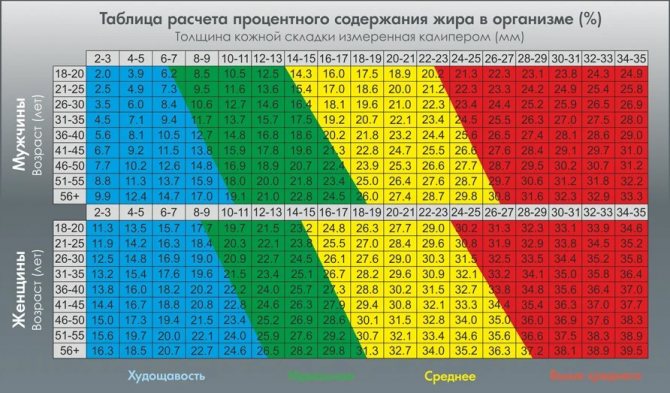
Correlation between sex, age and fold thickness measured by caliper
Types and properties of existing fats
All fats consist of three types: simple, complex and derivatives.
Simple fats are called triglycerides (TG) - they are glycerol and three fatty acid molecules.
Triglycerides are the bulk of fat in the human body and make up at least 90% of the total fat mass. TG accumulate in adipose and muscle tissue, in fact, being a concentrated source of energy (1 g of fat contains 9 kcal, carbohydrates and proteins are half as caloric), providing about 70% of the body’s energy expenditure.
Complex fats are called phospholipids, and their derivatives are called cholesterols.
There are also unsaturated, polyunsaturated and saturated fatty acids. The former include sunflower, corn, olive, cottonseed, soybean oil, poultry, nuts and seeds. It is characteristic that the above vegetable oils fully retain their beneficial qualities even after heat treatment.
Polyunsaturated fatty acids are not produced by the body independently, but are essential in the structure of nerve cells and transport oxygen to all organs and tissues.
In symbiosis with protein and cholesterol they represent the cell membranes of the human body. They are found in fish and fish oil, flaxseed and rapeseed oil, walnut oil and wheat germ.
Animal fats are saturated fatty acids.
By protecting the skin from drying out and internal organs from injury and cold, fats also transport vitamins throughout the body. Reducing the amount of fat in your diet can lead to heart problems and other complications. Saturated fatty acids contain meat, lard, milk fats, butter, palm and coconut oils, and cocoa butter.
At temperatures below 18-20 degrees, these substances are in a solid state.
Consequences of lack of fat
Lipids are a biological component of our body, like bricks in a building, present in every cell, participating in their division, growth and renewal. A lack of fat in cells slows down the regeneration and rejuvenation of the entire body , which will spoil the appearance of even the slenderest lady.
Failure of the brain to receive the required amount of it leads to deviations in the development of this organ, and therefore the whole organism, depression, tumors, various diseases and even paralysis.
The consequence of lipid deficiency is abnormalities in the functioning of internal organs, as well as weakened immunity, impaired vision, and impaired sexual function. Lack of fat leads to dry skin, it begins to crack due to hypothermia.
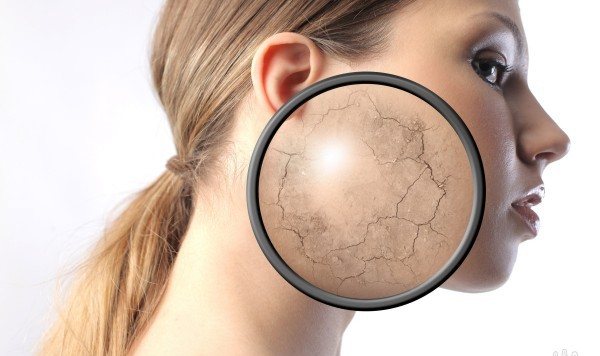
With a lack of fat under the skin, our body begins to somehow fight hypothermia. And it finds a way out in increasing hair growth. Hair all over your body not only grows more actively, but also becomes thicker. Therefore, everyone who passionately wants to get rid of “excess fat” should think about the consequences.
Unsaturated fatty acids
Unsaturated fatty acids are found mainly in foods of plant origin, as well as in fish. Unsaturated fatty acids are easily oxidized, they are not very resistant to heat treatment, so it is most useful to consume foods containing them in their raw form.
Unsaturated fatty acids are divided into two groups, depending on how many hydrogen-unsaturated bonds between atoms they contain. If there is only one such connection, these are monounsaturated fatty acids (MUFAs); if there are several of them, these are polyunsaturated fatty acids (PUFAs).


